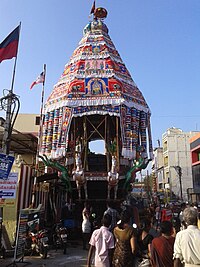Nageswaraswamy Temple
| Nageswaraswamy Temple | |
|---|---|
Kudanthai Keezhakottam | |
Cholas |
Nageswaraswamy Temple is a
There are many inscriptions associated with the temple indicating contributions from
The temple complex is one of the largest in the state and it houses three gateway towers known as
Legend
During the time when
History
The temple had been a centre of learning as seen from the inscriptions in the temple. The inscriptions indicate specific subjects like Purvamimansa styled as Pravahakarma. There were also provisions made for feeding and maintaining for teachers and students.[4] In modern times, the temple is maintained and administered by the Hindu Religious and Charitable Endowments Department of the Government of Tamil Nadu.[5]
Architecture
The temple is one of the prominent Shiva temples in
The Devi shrine is an independent structure situated in the outer
According to historian Harle, the temple is counted among the four early extant temples of the
During
Festivals and religious importance

The temple priests perform the
Religious importance
As per a Hindu belief, people troubled by Sarpa-dosha or Malefic effects Rahu-Kethu seek a relief by offering prayers in a single day to Kudanthai or Kumbakonam Nageshwarar in the morning, Thirunageshwaram Naganathar at the noon, Thirupamburam Pambureswarar in the evening and Nagoor Nageshwarar or Naganathar temple at night.[16]
Specialty
Nageswaraswamy Temple is one of the 12 Shiva temples that are connected with Mahamaham festival which happens once in 12 years in Kumbakonam. The other eleven temples are:[17]
- Kasi Visanathar Temple,
- Adi Kumbeswarar Temple,
- Someswarar Temple,
- Kalahasteeswarar Temple,
- Gowthameswarar Temple,
- Kodeeswarar Temple,
- Amirthakadeswarar Temple,
- Banapuriswarar Temple,
- Abimukeswarar Temple,
- Kambatta Viswanathar Temple and
- Ekambareswarar Temple.
Gallery
-
Shrine of the goddess
-
Innerprakara
-
Temple tree
-
Vimana of the presiding deity
-
Vimana of the goddess
-
Sculpture at Nagheshwara Temple
Notes
- ^ V., Meena (1974). Temples in South India (1st ed.). Kanniyakumari: Harikumar Arts. p. 25.
- ^ "campantar tEvAram -2" (PDF). projectmadurai.org. Retrieved 16 July 2011.
- ^ R. 2001, pp. 217-8
- ISBN 978-81-230-1896-6.
- ^ "Thirukoil - Temple list of Tamil Nadu" (PDF). Hindu Religious & Charitable Endowments Department, Government of Tamil Nadu. p. 216. Archived from the original (PDF) on 9 October 2020. Retrieved 30 August 2020.
- ISBN 978-93-83440-34-4.
- ^ ISSN 0012-8376. Retrieved 30 August 2020.
- ^ Temples of South India P.112. V.V. Subba Reddy
- ^ H., Sarkar (1974). The Kampahesvara temple at Thirubuvanam (PDF). Madras: Department of Archaeology, Government of Tamil Nadu. p. 9.
- ^ Harle, James C. (1958). The Brahmapuriswara temple at Pullamangai (PDF). Bombay: Bhulabhai Memorial Institute. p. 9.
- ^ "Sri Nageswarar temple". Dinamalar. 2019. Retrieved 25 April 2020.
- ^ "Kudanthai Keezhakottam". Dharumapuram Adheenam. 25 April 2020.
- ^ Swamigal, Tirunavukkarasu. "Tevaram Of Tirunavukkaracu Cuvamikal Tirumurai 5 part - 2 Poems(510-516)" (PDF). projectmadurai.org. pp. 33–34. Retrieved 13 December 2011.
- ISBN 9781684666041.
- ISBN 978-81-7907-053-6.
- ISBN 9788183682244.
- ^ Mahamaham Festival 2004 (in Tamil), Hindu Religious and Charitable Endowments Administration Department, Government of Tamil Nadu, 2004
References
- Ayyar, P. V. Jagadisa (1991). South Indian shrines: illustrated. New Delhi: Asian Educational Services. ISBN 81-206-0151-3..
- R., Dr. Vijayalakshmy (2001). An introduction to religion and Philosophy - Tévarám and Tivviyappirapantam (1st ed.). Chennai: International Institute of Tamil Studies.











